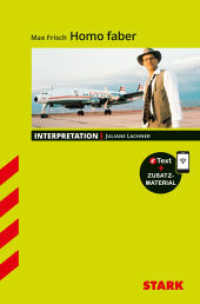- ホーム
- > 洋書
- > 英文書
- > Science / Mathematics
基本説明
The original Deep Marine Environments(Unwin Hyman) was first published in 1989, and quickly became established as the leading text in marine sedimentology. It is now regarded as a classic. This updated book is aimed at an advanced undergraduate or graduate level readership, and there will also be a important market amongst professional and research sedimentologists, particularly in the oil industry.
Full Description
Deep-water (below wave base) processes, although generally hidden from view, shape the sedimentary record of more than 65% of the Earth's surface, including large parts of ancient mountain belts. This book aims to inform advanced-level undergraduate and postgraduate students, and professional Earth scientists with interests in physical oceanography and hydrocarbon exploration and production, about many of the important physical aspects of deep-water (mainly deep-marine) systems. The authors consider transport and deposition in the deep sea, trace-fossil assemblages, and facies stacking patterns as an archive of the underlying controls on deposit architecture (e.g., seismicity, climate change, autocyclicity). Topics include modern and ancient deep-water sedimentary environments, tectonic settings, and how basinal and extra-basinal processes generate the typical characteristics of basin slopes, submarine canyons, contourite mounds and drifts, submarine fans, basin floors and abyssal plains.
Contents
Preface xi
About the companion website xiii
Part 1 Process and product 1
1 Physical and biological processes 3
1.1 Introduction 4
1.2 Shelf-edge processes 5
1.3 Deep, thermohaline, clear-water currents 12
1.4 Density currents and sediment gravity flows 16
1.5 Turbidity currents and turbidites 23
1.6 Concentrated density flows and their deposits 42
1.7 Inflated sandflows and their deposits 45
1.8 Cohesive flows and their deposits 46
1.9 Accumulation of biogenic skeletons and organic matter 52
2 Sediments (facies) 59
2.1 Introduction 60
2.2 Facies classifications 60
2.3 Facies Class A: Gravels, muddy gravels, gravelly muds, pebbly sands, ≥5% gravel grade 65
2.4 Facies Class B: Sands, >80% sand grade, 80% mud, ≥40% silt, 0-20% sand 85
2.7 Facies Class E: ≥95% mud grade, 75% biogenics), muddy oozes (50-75% biogenics), biogenic muds (25-50% biogenics) and chemogenic sediments, <5% terrigenous sand and gravel 102
2.10 Injectites (clastic dykes and sills) (Figs 2.46-2.50) 105
2.11 Facies associations 111
3 Deep-water ichnology 112
3.1 Introduction 112
3.2 General principles of ichnology 113
3.3 Colonisation of SGF deposits: Opportunistic and equilibrium ecology 122
3.4 Ichnofacies 125
3.5 Ichnofabrics 127
3.6 Trace fossils in core 128
3.7 Case study I: Trace fossils as diagnostic indicators of deep-marine environments, Middle Eocene Ainsa-Jaca basins, Spanish Pyrenees 129
3.8 Case study II: Subsurface ichnological characterisation of the Middle Eocene Ainsa deep-marine system, Spanish Pyrenees 130
3.9 Summary of ichnology studies in deep-water systems 134
3.10 Concluding remarks 134
4 Time-space integration 136
4.1 Introduction 136
4.2 Submarine fan growth phases and sequence stratigraphy 144
4.3 Tectono-thermal/glacio-eustatic controls at evolving passive continental margins 153
4.4 Eustatic sea-level changes at active plate margins 154
4.5 Changing relative base level and sediment delivery processes 160
4.6 Autocyclic processes 164
4.7 Palaeo-seismicity and the stratigraphic record 171
4.8 Deconvolving tectonic and climatic controls on depositional sequences in tectonically active basins: Case study from the Eocene, Spanish Pyrenees 171
4.9 Problems in determining controls on sediment delivery 183
4.10 Carbonate versus siliciclastic systems 191
4.11 Computer simulations of deep-water stratigraphy 193
4.12 Laboratory simulations of deep-water stratigraphy 193
4.13 Supercritical versus subcritical fans 194
4.14 Hierarchical classification of depositional units 195
4.15 Concluding comments 196
5 Statistical properties of sediment gravity flow (SGF) deposits 200
5.1 Introduction 200
5.2 Cloridorme Formation, Middle Ordovician, Québec 205
5.3 Vertical trends 218
Part 2 Systems 237
6 Sediment drifts and abyssal sediment waves 239
6.1 Introduction 239
6.2 Distribution and character of contourites and sediment drifts, North Atlantic Ocean 241
6.3 Facies of muddy and sandy contourites 251
6.4 Seismic facies of contourites 255
6.5 The debate concerning bottom-current reworking of sandy fan sediments 255
6.6 Ancient contourites 257
6.7 Facies model for sediment drifts 260
7 Submarine fans and related depositional systems: modern 262
7.1 Introduction 262
7.2 Major controls on submarine fans 266
7.3 Submarine canyons 274
7.4 Architectural elements of submarine-fan systems 277
7.5 The distribution of architectural elements in modern submarine fans 303
7.6 Modern non-fan dispersal systems 303
7.7 Concluding remarks 307
8 Submarine fans and related depositional systems: ancient 309
8.1 Introduction 309
8.2 Ancient submarine canyons 311
8.3 Ancient submarine channels 313
8.4 Comparing modern and ancient channels 355
8.5 Ancient lobe, lobe-fringe, fan-fringe and distal basin-floor deposits 357
8.6 Seafloor topography and onlaps 369
8.7 Scours 377
8.8 Basin-floor sheet-like systems 382
8.9 Prodeltaic clastic ramps 387
8.10 Concluding remarks 393
Part 3 Plate tectonics and sedimentation 403
9 Evolving and mature extensional systems 405
9.1 Introduction 406
9.2 Models for lithospheric extension 408
9.3 Subsidence and deep-water facies of rifts and young passive margins 410
9.4 The post-breakup architecture of passive margins 413
9.5 Failed rift systems 428
9.6 Fragments of ancient passive margins 429
9.7 Concluding remarks 430
10 Subduction margins 433
10.1 Introduction 433
10.2 Modern subduction factories 435
10.3 Arc-arc collision zones 474
10.4 Forearc summary model 482
10.5 Marginal/backarc basins 483
10.6 Ancient convergent-margin systems 488
10.7 Forearc/backarc cycles 493
10.8 Concluding remarks 493
11 Foreland basins 497
11.1 Introduction 498
11.2 Modern foreland basins 499
11.3 Ancient deep-marine foreland basins 506
11.4 Concluding remarks 523
12 Strike-slip continental margin basins 528
12.1 Introduction 528
12.2 Kinematic models for strike-slip basins 529
12.3 Suspect terranes 529
12.4 Depositional models for strike-slip basins 532
12.5 Modern strike-slip mobile zones 537
12.6 Ancient deep-marine oblique-slip mobile zones 557
12.7 Concluding remarks 566
References 573
Index 647








